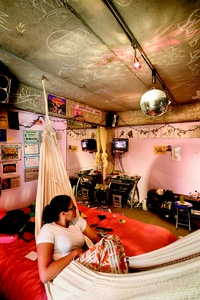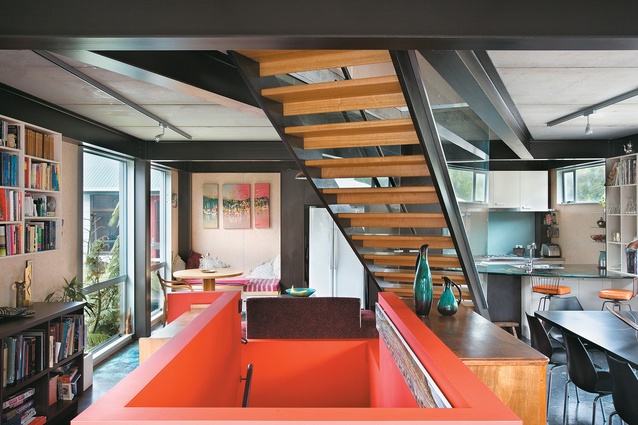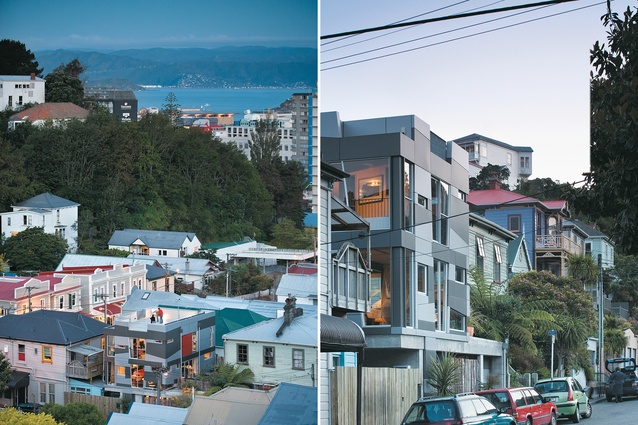Houses Revisited: Valley girls
From our 2007 archives: With architect John Mills as guide two Wellington clients brave Doubt and Despair to build their House Beautiful.
Wellington’s Aro Valley has – like the little engine – long been the inner city suburb that could. Beset by a climate you wouldn’t wish on your worst enemy (there are houses in Devon Street whose timbers haven’t seen the light of day since they cut down and milled), it has always attracted strong individuals and even stronger collectives. Bound together in social causes this is the Land of the Alternative, the Valley of Opposition.
Aro Valley’s residents are fierce defenders of heritage. In this part of town, the worst insult is ‘developer’. Which is ironic, given the origins of the suburb and its housing stock: simple workers’ cottages built at the turn of the twentieth century by builders out to make a quick quid – the spec developers of their time. Wherever you see three identical Aro Valley houses in a row you can be sure it was a developer who built them. The artefacts of Victorian and Edwardian commerce and capitalism are now hailed as icons of heritage and socialism. Funny old world.
On the corner of Aro and Epuni Streets stood a butcher’s shop, the archetype of the local and laudable. In the ’90s Francesca Brice and Kate Jason-Smith bought it and converted it to the Mermaid Guest House for women, a place that grew in fame and popularity, particularly with women from out of town. A few years ago when the owners were looking for a house site a valuer suggested they use what they already owned: the butcher’s back yard.
Ms Brice and Ms Jason-Smith approached architect John Mills, with whom they had previously worked. And so the three of them set off on a journey up the craggy peaks and through the dark swamps of the Wellington City Council’s planning bylaws – a trek that came to rival Frodo and Sam’s epic slog through Mordor. Attacked on all sides by the slings and arrows of heritage, drawn into the murky depths of the Environment Court, still they persevered. For their troubles, the clients now have a distinct and delightful home: an urban house like no other in a suburb where all others are alike.

Three Epuni Street is a worker’s cottage for the twenty-first century. A concrete and steel box clad in aluminium panelling which tessellates every surface like crazy paving, this is a house for a new age. It stands proud and defiant and squares off against the street. At street level it presents a door for people and one for a car, two cabbage trees and a fence of totara rough on one face and machined on the others – a comment, perhaps, on what it means to live in the city. Behind this fence is a tiny courtyard of gravel with a hammock that gives the bedroom beyond a sense of privacy and a glimpse of nature.
Inside, the three-storeyed house reveals itself to be one of three stories. Each floor is a world in itself, but one that relates to others. The ground floor has the bedrooms of the two teenage girls, each with its own courtyard. The bedroom at the rear shares its courtyard with the existing guest house where the girls’ grandmother lives. A bathroom, garage and workshop complete the story. The workshop is home to the owners’ perfumery business (the scent from which drifts up through the house) – their cottage industry, if you like. As John Mills describes the house: “This is a worker’s cottage that looks back and forward in time”. This story, then, is all work and some play.

Opposite the front door is a stair that rises and then turns sharply to the left. It brings you into a large open space where the living is easy. Or not quite. The plan – like the façade to the street – is fragmented, creating several smaller spaces. The stair to the top floor bisects the space diagonally, both horizontally and vertically, creating many worlds around it – spaces assembled clockwise around the stair. The first is a small and sunny sitting area with a window to the north that sucks in the heat. Next, the kitchen along the back wall and tucked into the corner, that folds into another small sitting area at the kitchen bench, with its own shelves.
High above the kitchen is a small window to the south offering a surprising and welcome view. Beyond this is the dining table adjacent to large doors leading on to a deck over the garage. Another sitting area with the TV brings us to the front of the house and the windows to the west. A small desk and chair defines this as the drawing room and leads us to the sunny northwest corner, heaven in winter. Squeezed between the entry stair and the north wall is the bookworld which, with the corridor it creates, completes the circle.
This is a truly remarkable space. The architect has taken a bland rectangle and produced nine distinct spaces whose boundaries are both blurred and defined at the same time. On each wall windows are positioned to steal sun or reveal views. John Mills has challenged the history of the compartmentalised interior by breaking down the walls and reassembling the compartments without them. In doing so he has made the private public – a complex and intriguing story.
The diagonal stair, all glass, steel and transparency, leads to the private world of the bedrooms and the story takes a twist. Downstairs, the orthogonal geometry of the site and the house prevail, albeit interrupted occasionally by an acute angle; here, the diagonal is queen. The stair leads to a corner suntrap with a big sliding window and a rusty steel handrail. A working area sits in the lee of the stair and the floor is divided into two bedrooms – each its own world – connected by a round bathroom, lit from above with an over-sized skylight. This, the only curve in the building, indicates we are in a feminine world and there by invitation. Small screens pierce the walls; the walls are made of light; where the living floor was characterised by openness, this floor is about enclosure.
At the rear of the floor is a stair, almost invisible, that leads to the roof deck where solar panels share space with the occasional dancer. It is here that Aro Valley can be truly appreciated as groups of houses that, like this one, love their landscape. Here is the Valley of Courage and Innovation. This house is not the enemy of Aro Valley values. but a true adherent of them.
Click here to see more Houses Revisited. And sign up to our email newsletters to receive Houses Revisited straight to your inbox.
Note: These are stories from our archives and, since the time of writing, some details may have changed including names, personnel of specific firms, registration status, etc.












